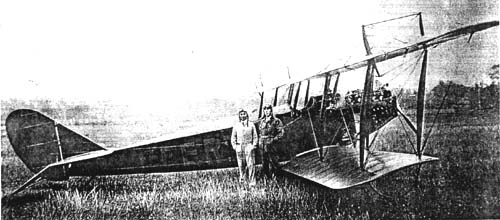PHILIPPINE
AIR SERVICE
1920 - 1921
With
a franchise in hand from the Curtiss Company, an aviation school established,
and at least 40 cadets
guaranteed
for training, Stevenot and Croft launched their flight school. The principal
flight instructor for the new Curtiss Flying School would be Alfred Croft.
Training
at the new aviation school was divided into two curricula: flying and ground
training. Croft was responsible for the cadets' flight training, while
Robert Johnson would serve as a ground school instructor. In addition to
the two principal instructors, Major Stevenot recruited others who helped
to complement and round-off each cadet's formal flight training. Lieutenant
Carrol V. Stein, formerly an officer in the U.S. Army Air Service, served
as the school's radio and aerial navigation officer and assisted Croft
in flying. Johnson, having been a former U.S. Naval Air Service mechanic,
served as the principal instructor in aircraft mechanics and rigging. Father
Jose Algue, S.J., who was the assistant Director of the Philippine Weather
Bureau, taught the cadets meteorology and weather conditions. Other instructors
at the school included Lieutenant Evans of the U.S. Army Air Service, who
had served with distinction in the Kosciusko Aero Squadron in Poland, and
Captain Day, United States Marine Corps. Both were highly talented pilots.
Major
Stevenot designed the Curtiss School of Aviation to follow closely the
course of instruction for the U.S. Navy flying school which he believed
to be the most comprehensive and best suited for pilots flying in the Philippine
Islands. The school's ground training took place at Fort Mills on Corregidor.
The flight training required pilots to be qualified to fly land-based aircraft
and seaplanes, and to be proficient at aerial navigation and radio work.
Each
pilot was trained to break down and repair engines, rig and re-rig aircraft
and to be able to handle the seaplanes on open water. Each pilot was required
to know his aircraft inside and out and to be able to make repairs. Major
Stevenot and the other instructors knew that in the more remote islands
of the Philippines far from any repair facility, each pilot would need
to have the skills and knowledge to repair and maintain his aircraft. This
type of comprehensive training would give the future aviators the skills
needed, not only to keep them flying, but also to keep them alive.
The
aviation cadets went through rigorous training and course work, which included
aerial navigation, straight-line flight on designated courses, triangle
flight on designated points, and cross-country and inter-island flying.
Each element of this ground school training would help a future pilot to
keep flying in primitive and dangerous terrain.
Each
cadet who graduated from the Curtiss School of Aviation would be certificated
in flight, engine mechanics, aircraft rigging and construction. The success
and enthusiasm of the cadets was not only being closely watched by the
school's administration, but they were also being observed by influential
members of the Insular Government and the Philippine Aero Club. The President
of the Philippine Aero Club was Philippine Senate President Manuel Quezon,
who at the outbreak of the Second World War would be the President of the
Philippine Commonwealth. Senator Quezon adamantly believed in the importance
and long-term potential of commercial and military aviation for the Philippine
Islands to prosper and eventually to defend itself.
On
January 9, 1920, Alfredo Carmelo made history when he became the first
Curtiss School of Aviation student to solo in the Seagull, two months after
beginning his flight training. Under Croft's watchful eye, he began his
pre-flight inspection of the Seagull, making sure that everything was in
proper order, and then climbed into the cockpit. After checking his instrumentation
he turned over his 360-hp Liberty 12 engine and was released from the small
floating dock. Powering up his engine, he began his takeoff on a calm and
flat sea. After a short flight he proceeded to make three takeoffs and
landings.
Carmelo
had originally taken flying lessons when he was a student in Germany before
the First World War and had never lost his love of being behind the stick
in the cockpit. When he landed his airplane, he was greeted with great
enthusiasm by Croft who initiated his student into the fraternity of pilots
by promptly dumping him overboard into the bay—a tradition that would continue
and be welcomed by each cadet who soloed.

Curtiss
Aviation School flight instructor Croft along with pilot Lefert
(pictured
near the wing) along with one of their Curtiss Jennys.
|

